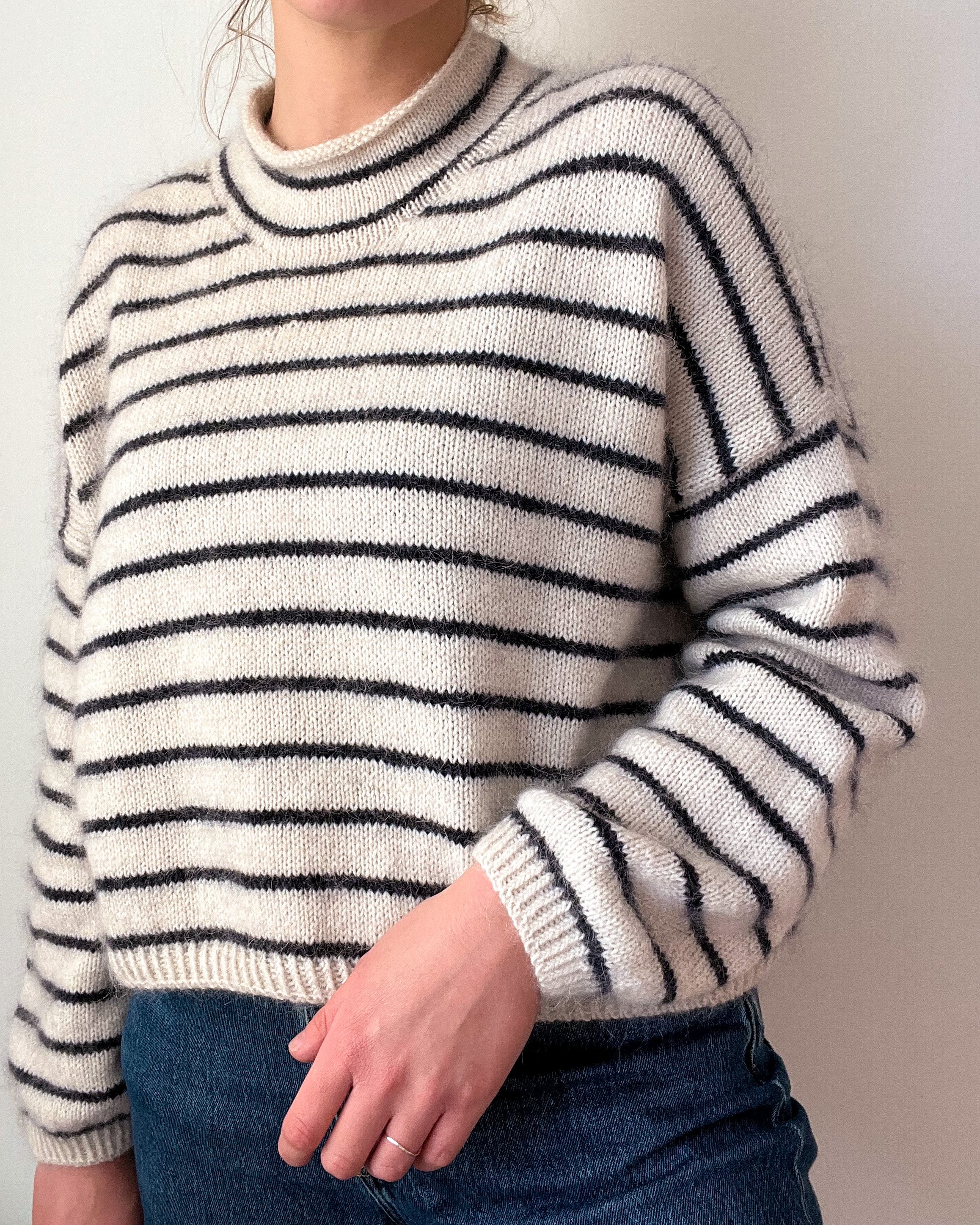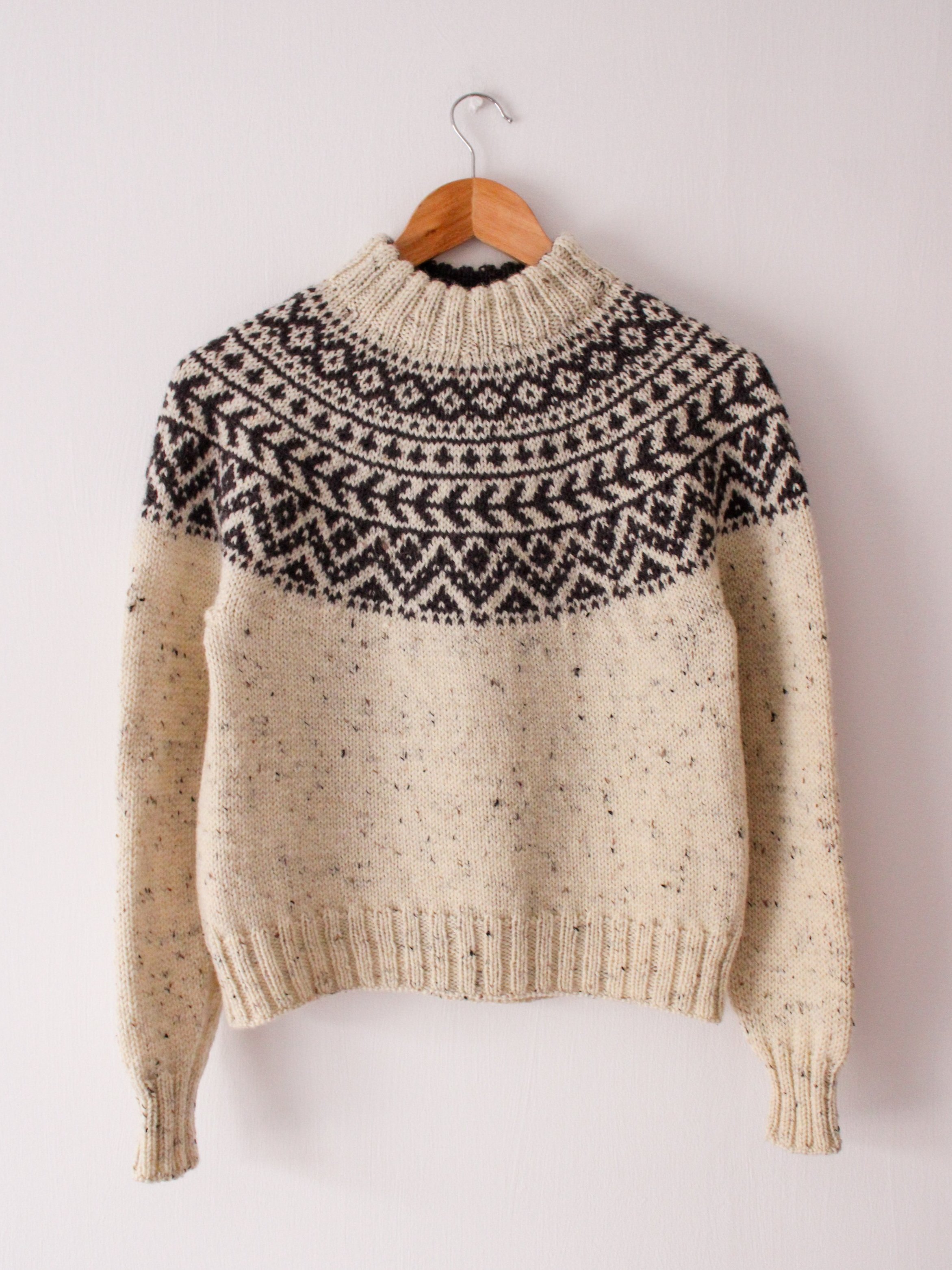Farnham Sweater
The Farnham Sweater is an oversized drop-shoulder sweater with stripes and a funnel-neck collar worked top-down, both flat and in the round. The fit is very relaxed and slouchy, and the sleeves have a slight taper. The back panel is worked first with German short-row shaping to create sloping shoulders. Once the back panel is worked the stitches are left to rest, and you will move on to work the shoulders. The left shoulder is worked first with German short rows, and you then work the right shoulder, also with German short rows. You then join the two shoulders together and work the front panel to the same depth as the back panel. Next, you will join the front and back panels together to be worked in the round (with optional body shaping to create a tapered silhouette) until you are happy with the length. You then pick up and knit the stitches for each sleeve, working decreases to give the sleeves a little bit more shape. To finish, you pick up and knit the collar, which is also worked with some decreases to give it a funnel shape.
Please note that this is a digital pdf and not a physical knitting pattern.
For pattern support, please email me or use the contact form linked above.
The Farnham Sweater is an oversized drop-shoulder sweater with stripes and a funnel-neck collar worked top-down, both flat and in the round. The fit is very relaxed and slouchy, and the sleeves have a slight taper. The back panel is worked first with German short-row shaping to create sloping shoulders. Once the back panel is worked the stitches are left to rest, and you will move on to work the shoulders. The left shoulder is worked first with German short rows, and you then work the right shoulder, also with German short rows. You then join the two shoulders together and work the front panel to the same depth as the back panel. Next, you will join the front and back panels together to be worked in the round (with optional body shaping to create a tapered silhouette) until you are happy with the length. You then pick up and knit the stitches for each sleeve, working decreases to give the sleeves a little bit more shape. To finish, you pick up and knit the collar, which is also worked with some decreases to give it a funnel shape.
Please note that this is a digital pdf and not a physical knitting pattern.
For pattern support, please email me or use the contact form linked above.
The Farnham Sweater is an oversized drop-shoulder sweater with stripes and a funnel-neck collar worked top-down, both flat and in the round. The fit is very relaxed and slouchy, and the sleeves have a slight taper. The back panel is worked first with German short-row shaping to create sloping shoulders. Once the back panel is worked the stitches are left to rest, and you will move on to work the shoulders. The left shoulder is worked first with German short rows, and you then work the right shoulder, also with German short rows. You then join the two shoulders together and work the front panel to the same depth as the back panel. Next, you will join the front and back panels together to be worked in the round (with optional body shaping to create a tapered silhouette) until you are happy with the length. You then pick up and knit the stitches for each sleeve, working decreases to give the sleeves a little bit more shape. To finish, you pick up and knit the collar, which is also worked with some decreases to give it a funnel shape.
Please note that this is a digital pdf and not a physical knitting pattern.
For pattern support, please email me or use the contact form linked above.
Materials & Fit
Notions: 3 mm/US 2.5 (80- and/or 100-cm/32- and/or 40-in cord) and 4 mm/US 6 (60-, 80-, and 100-cm/24-, 32-, and 40-in cord) circular needles. You may also find some 3 mm/US 2.5 and 4 mm/US 6 double-pointed knitting needles useful for the sleeves, but this is optional.
You will also need a few stitch markers, a darning needle, and some spare needles/scrap yarn/stitch holders where the stitches of the sleeves will rest. At least 2 of the stitch markers should have a clip-on mechanism to help you keep track of your progress, especially when mapping out the short row shaping.
Yarn: Approximately 4 (4-5) 5 (5) 5, (5) 5-6 (6) 6-7 (7) 7-8 skeins in your main colour and approximately 1 (1-2) 2 (2) 2, (2) 2 (2) 2 (2) 2-3 skeins in your contrast colour of Sandnes Garn Sunday (100% merino wool; 50 g = 235 m/257 yds) held together with approximately 4 (4) 5 (5) 5, (5) 5-6 (6) 6 (6) 7 skeins in your main colour and approximately 1-2 (1-2) 2 (2) 2, (2) 2 (2) 2 (2) 2-3 skeins in your contrast colour of Sandnes Garn Tynn Silk Mohair (57% mohair, 15% wool, and 28% silk; 25 g = 212m/232 yds). Please note that these estimates are probably slightly generous and are based on test knitters' feedback.
For the first sample garment (Size D, no body shaping), I used 5 skeins of Sandnes Garn PetiteKnit Sunday in the shades Whipped Cream 1012 (main colour) and 2 skeins of Sailor in the Dark 5581 (contrast colour), held with 6 skeins of Sandnes Garn Tynn Silk Mohair in the shades Kitt 1015 (main colour) and 2 skeins of Marine 5581 (contrast colour).
For the second sample garment (Size B, with body shaping), I used 4 skeins of Sandnes Garn PetiteKnit Sunday in the shade Whipped Cream 1012 (main colour) and 1 skein of Knitting for Olive Merino in the shade Dusty Sea Green (contrast colour) held with 5 skeins of Sandnes Garn Tynn Silk Mohair in the shade Off-White 1012 (main colour) and 1 skein of Knitting For Olive Soft Silk Mohair in the shade Dusty Sea Green (contrast colour). Without the body shaping, I would have needed a second skein of both contrast colour yarns.
In metres and yards, the estimated yardage works out to be:
Quantity | of Sunday | of Tynn Silk Mohair
1 | 235 m (257 yrds) | 212 m (232 yrds)
2 | 470 m (514 yrds) | 424 m (464 yrds)
3 | 705 m (771 yrds) | 636 m (696 yrds)
4 | 940 m (1,028 yrds) | 848 m (928 yrds)
5 | 1,175 m (1285 yrds) | 1,060 m (1,160 yrds)
6 | 1,410 m (1,542 yrds) | 1,272 m (1,392 yrds)
7 | 1,645 m (1,799 yrds) | 1,484 m (1,624 yrds)
8 | 1,880 m (2,056 yrds) | 1,696 m (1,856 yrds)
Yarn alternatives: Good alternatives for Sandnes Garn Sunday include (but are not limited to) Along Avec Anna Merino (100% superwash merino; 50 g = 200 m/219 yds), Knitting for Olive Merino (100% merino; 50 g = 250 m/273 yds), and Sandnes Garn Tynn Peer Gynt (100% Norwegian wool; 50 g = 205 m/224 yds. Good alternatives for Sandnes Garn Tynn Silk Mohair include Drops Kid-Silk (75% mohair, 25% silk; 25 g = 210 m/230 yds), Knitting for Olive Soft Silk Mohair (70% mohair, 30% silk; 25 g = 225m/246 yds), Along Avec Anna Silk Mohair (72% kid mohair, 28% mulberry silk; 25 g = 210 m/230 yds), and CaMaRose Midnatssol (54% baby alpaca, 36% Tencel, 10% merino wool; 25 g = 200 m/219 yds). If you prefer to work with a single strand, a sport-weight yarn like Istex Kambgarn (100% merino wool, 50g = 150 m/164 yrds) would be ideal.
Tension: 22 sts x 32 rows and rounds in stocking stitch on 4 mm needles. Make sure to wash and block your swatch for the most accurate results.
Sizing and ease: The Farnham Sweater has a recommended positive ease of 35-40 cm/13.75-15.75 in around the chest (or the widest part of your torso). I am aware that this is a lot of positive ease and that you may not wish to pick a size with this amount of ease depending on your preferences. As such, you should feel free to pick a size with less positive ease relative to your body using the measurements given below. If in doubt, I recommend measuring a garment you already own that is also oversized and using that as a guideline to help you find your preferred fit.
Having had many conversations with plus-size knitters about this topic, I would probably recommend that if your chest measurement fits within the boundaries of Sizes G, H, or I, you pick a size with 25-30 cm/9.75-11.75 in positive ease around the chest. If your chest measurement fits within the boundaries of Sizes J or K, I would recommend that you pick a size with 15-20 cm/6-8 in positive ease around the chest. That being said, I have graded the pattern with fixed ease (meaning each size is 35-40 cm/13.75-15.75 in larger in circumference than the corresponding chest measurement of the wearer) to give all sizes both options of fixed and relative ease. You can also work body shaping to tailor the fit as desired.
You have the option of mixing and matching the body and sleeve sizes with this pattern. The sleeves have a recommended positive ease of 10-15 cm/4-6 in. With this in mind, you should still work the yoke to the depth stated for your recommended size based on your upper bicep measurement with fixed ease and pick up the number of sleeve stitches for your recommended size.
To illustrate, let’s say that I have a chest measurement of 112 cm/44 in and an upper bicep measurement of 33 cm/13 in. This would put me in the boundary of Size H for both the chest and the upper bicep. If I were to knit my recommended size, my final garment would measure 150 cm/59 in in circumference with a positive ease of 38 cm/15 in compared with my chest measurement. Let’s also say that I wanted something closer to 25-30 cm/9.75-11.75 in positive ease around the chest. Size F would give me 28 cm/11 in positive ease and would therefore be my ideal size. I should therefore cast-on the number of stitches given for Size F and pick up the number of shoulder stitches for Size F, but still work the yoke to the stated depth for Size H and pick up the number of sleeve stitches given for Size H but the sleeve length and decrease interval for Size F.
For reference, the first sample garment I made (with blue stripes) has a full positive ease of 38 cm/15 in on my 92-cm/36.25-in chest, whereas the second (with green stripes) has 28 cm/11 in positive ease. I also incorporated the optional body shaping to create a more tapered silhouette. You can see how this looks in practice in the photos found on pages 24-27 of the pattern document. If you need additional help with this, please email me for pattern support (keeping in mind I may take up to 7 working days to reply). My email address is the.knit.purl.girl2020@gmail.com.
Size: A (B) C (D) E, (F) G (H) I (J) K
Chest measurement (cm): 75-80 (80-85) 85-90 (90-95) 95-100, (100-105) 105- 110 (110-115) 115-125 (125-135) 135-145
Chest measurement (in): 29.5-31.5 (31.5-33.5) 33.5-35.5 (35.5-37.5) 37.5-39.25, (39.25-41.25) 41.25-43.25 (43.25-45.25) 45.25-49.25 (49.25-53.25) 53.25-57
Actual circumference of garment (cm): 114.5 (120) 124.5 (130) 135.5, (140) 145.5 (150) 157.5 (167.5) 177.5
Actual circumference of garment (in): 45 (47.25) 49 (51.25) 53.25, (55) 57.25 (59) 62 (65.75) 69.75
Actual yoke depth (cm): 17.5 (17.5) 18.75 (18.75) 20, (20) 21.25 (21.25) 22.5 (23.75) 26.25
Actual yoke depth (in): 7 (7) 7.5 (7.5) 7.75, (7.75) 8.25 (8.25) 8.75 (9.25) 10.25
Sleeve circumference at upper bicep (cm): 38 (38) 41 (41) 43.5, (43.5) 46.5 (46.5) 49 (52) 57.5
Sleeve circumference at upper bicep (in): 15 (15) 16 (16) 17.25, (17.25) 18.25 (18.25) 19.25 (20.5) 22.5
Recommended sleeve length (cm): 37 (34) 34 (34) 30.75, (30.75) 27.75 (27.75) 27.75 (24.5) 21.5
Recommended sleeve length (in): 14.5 (13.5) 13.5 (13.5) 12, (12) 11 (11) 11 (9.75) 8.5
Recommended length from bottom of collar to hem (cm): 46 (46) 49.25 (49.25) 52.5, (52.5) 55.75 (59) 62.25 (65.5) 68.75 cm
Recommended length from bottom of collar to hem (in): 18 (18) 19.5 (19.5) 20.75, (20.75) 22 (23.25) 24.5 (25.75) 27


















